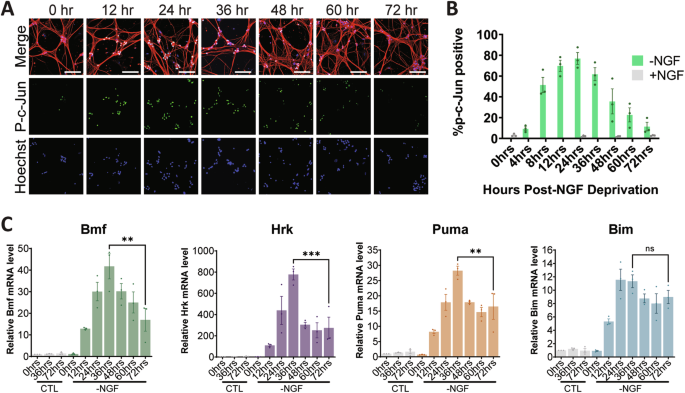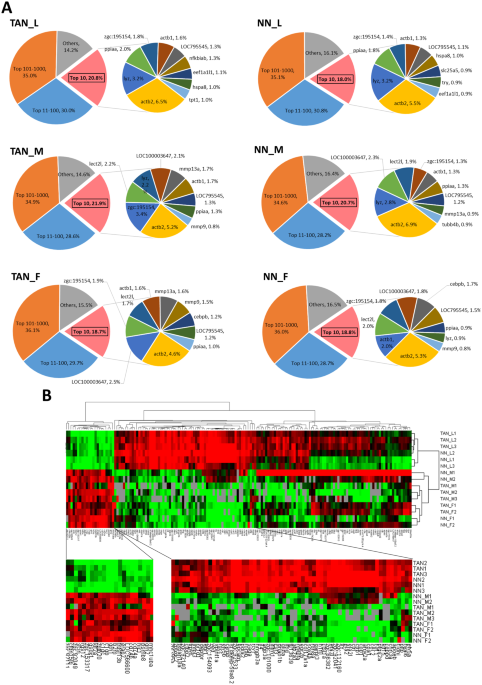
- Select a language for the TTS:
- UK English Female
- UK English Male
- US English Female
- US English Male
- Australian Female
- Australian Male
- Language selected: (auto detect) - EN
Play all audios:
ABSTRACT Apoptosis is a fundamental process of all mammalian cells but exactly how it is regulated in different primary cells remains less explored. In most contexts, apoptosis is engaged to
eliminate cells. However, postmitotic cells such as neurons must efficiently balance the need for developmental apoptosis _versus_ the physiological needs for their long-term survival.
Neurons are capable of reversing the commitment to death even after the point of cytochrome _c_ release. This ability of neurons to recover from an apoptotic signal suggests that activation
of the apoptotic pathway in neurons could be much more transient than is currently recognized. Here, we investigated whether the apoptotic pathway in neurons is a persistent signal or a
transient pulse in continuous presence of apoptotic stimulus. We have examined this at three key steps in apoptotic signaling: phosphorylation of c-Jun, induction of the BH3-only family
proteins and Bax activation. Strikingly, we found all three of these events occur as transient signals following Nerve Growth Factor (NGF) deprivation-induced apoptosis in sympathetic
neurons. This transient apoptosis signal would effectively allow neurons to reset and permit recovery if the apoptotic stimulus is reversed. Excitingly, we have also discovered that a
neuron’s ability to recover from an apoptotic signal is dependent on expression of the anti-apoptotic Bcl-2 family protein Bcl-xL. Bcl-xL-deficient neurons lose the ability to recover from
NGF deprivation even if NGF is restored. Additionally, we show that recovery from a previous exposure to NGF deprivation is protective against subsequent deprivation. Together, these results
define a novel mechanism by which apoptosis is regulated in neurons where the transient pulse of the apoptotic signaling supports neuronal resilience. Access through your institution Buy or
subscribe This is a preview of subscription content, access via your institution ACCESS OPTIONS Access through your institution Subscribe to this journal Receive 12 print issues and online
access $259.00 per year only $21.58 per issue Learn more Buy this article * Purchase on SpringerLink * Instant access to full article PDF Buy now Prices may be subject to local taxes which
are calculated during checkout ADDITIONAL ACCESS OPTIONS: * Log in * Learn about institutional subscriptions * Read our FAQs * Contact customer support SIMILAR CONTENT BEING VIEWED BY OTHERS
DIVERSE MATURITY-DEPENDENT AND COMPLEMENTARY ANTI-APOPTOTIC BRAKES SAFEGUARD HUMAN IPSC-DERIVED NEURONS FROM CELL DEATH Article Open access 21 October 2022 SURVIVAL OF COMPROMISED ADULT
SENSORY NEURONS INVOLVES MACROVESICULAR FORMATION Article Open access 24 November 2022 STRESSED NEURONAL CELLS CAN RECOVER FROM PROFOUND MEMBRANE BLEBBING, NUCLEAR CONDENSATION AND
MITOCHONDRIAL FRAGMENTATION, BUT NOT FROM CYTOCHROME C RELEASE Article Open access 08 July 2023 DATA AVAILABILITY Because no large datasets were generated or analyzed in this current study,
data sharing is not applicable to this article. REFERENCES * Hollville E, Romero SE, Deshmukh M. Apoptotic cell death regulation in neurons. FEBS J. 2019;286:3276–98. Article PubMed PubMed
Central CAS Google Scholar * Kole AJ, Annis RP, Deshmukh M. Mature neurons: equipped for survival. Cell Death Dis. 2013;4:e689. Article PubMed PubMed Central CAS Google Scholar *
Glebova NO, Ginty DD. Growth and survival signals controlling sympathetic nervous system development. Annu Rev Neurosci. 2005;28:191–222. Article PubMed CAS Google Scholar * Kristiansen
M, Ham J. Programmed cell death during neuronal development: the sympathetic neuron model. Cell Death Differ. 2014;21:1025–35. Article PubMed PubMed Central CAS Google Scholar * Sun YF,
Yu LY, Saarma M, Timmusk T, Arumae U. Neuron-specific Bcl-2 homology 3 domain-only splice variant of Bak is anti-apoptotic in neurons, but pro-apoptotic in non-neuronal cells. J Biol Chem.
2001;276:16240–7. Article PubMed CAS Google Scholar * Uo T, Kinoshita Y, Morrison RS. Neurons exclusively express N-Bak, a BH3 domain-only Bak isoform that promotes neuronal apoptosis. J
Biol Chem. 2005;280:9065–73. Article PubMed CAS Google Scholar * Lin L, Zhang M, Stoilov P, Chen L, Zheng S. Developmental attenuation of neuronal apoptosis by neural-specific splicing
of Bak1 microexon. Neuron. 2020;107:1180–96.e8. Article PubMed PubMed Central CAS Google Scholar * Deckwerth TL, Elliott JL, Knudson CM, Johnson EM, Snider WD, Korsmeyer SJ. BAX is
required for neuronal death after trophic factor deprivation and during development. Neuron. 1996;17:401–11. Article PubMed CAS Google Scholar * Putcha GV, Deshmukh M, Johnson EM Jr.
Inhibition of apoptotic signaling cascades causes loss of trophic factor dependence during neuronal maturation. J Cell Biol. 2000;149:1011–8. Article PubMed PubMed Central CAS Google
Scholar * Vaughn AE, Deshmukh M. Glucose metabolism inhibits apoptosis in neurons and cancer cells by redox inactivation of cytochrome c. Nat Cell Biol. 2008;10:1477–83. Article PubMed
PubMed Central CAS Google Scholar * Yakovlev AG, Ota K, Wang G, Movsesyan V, Bao WL, Yoshihara K, et al. Differential expression of apoptotic protease-activating factor-1 and caspase-3
genes and susceptibility to apoptosis during brain development and after traumatic brain injury. J Neurosci. 2001;21:7439–46. Article PubMed PubMed Central CAS Google Scholar * Wright
KM, Linhoff MW, Potts PR, Deshmukh M. Decreased apoptosome activity with neuronal differentiation sets the threshold for strict IAP regulation of apoptosis. J Cell Biol. 2004;167:303–13.
Article PubMed PubMed Central CAS Google Scholar * Potts PR, Singh S, Knezek M, Thompson CB, Deshmukh M. Critical function of endogenous XIAP in regulating caspase activation during
sympathetic neuronal apoptosis. J Cell Biol. 2003;163:789–99. Article PubMed PubMed Central CAS Google Scholar * Deshmukh M, Kuida K, Johnson EM Jr. Caspase inhibition extends the
commitment to neuronal death beyond cytochrome c release to the point of mitochondrial depolarization. J Cell Biol. 2000;150:131–43. Article PubMed PubMed Central CAS Google Scholar *
Martinou I, Desagher S, Eskes R, Antonsson B, Andre E, Fakan S, et al. The release of cytochrome c from mitochondria during apoptosis of NGF-deprived sympathetic neurons is a reversible
event. J Cell Biol. 1999;144:883–9. Article PubMed PubMed Central CAS Google Scholar * Tang Ho M, Tang Ho L. Anastasis: recovery from the brink of cell death. R Soc Open Sci.
2019;5:180442. Article Google Scholar * Nano M, Montell DJ. Apoptotic signaling: beyond cell death. Semin Cell Dev Biol. 2024;156:22–34. Article PubMed Google Scholar * Ichim G, Tait
SW. A fate worse than death: apoptosis as an oncogenic process. Nat Rev Cancer. 2016;16:539–48. Article PubMed CAS Google Scholar * Tang HL, Tang HM, Hardwick JM, Fung MC. Strategies for
tracking anastasis, a cell survival phenomenon that reverses apoptosis. J Vis Exp. 2015;96:e51964. * Kalkavan H, Chen MJ, Crawford JC, Quarato G, Fitzgerald P, Tait SWG, et al. Sublethal
cytochrome c release generates drug-tolerant persister cells. Cell. 2022;185:3356–74.e22. Article PubMed PubMed Central CAS Google Scholar * Deshmukh M, Du C, Wang X, Johnson EM Jr.
Exogenous smac induces competence and permits caspase activation in sympathetic neurons. J Neurosci. 2002;22:8018–27. Article PubMed PubMed Central CAS Google Scholar * Nakamura A,
Swahari V, Plestant C, Smith I, McCoy E, Smith S, et al. Bcl-xL is essential for the survival and function of differentiated neurons in the cortex that control complex behaviors. J Neurosci.
2016;36:5448–61. Article PubMed PubMed Central CAS Google Scholar * Knudson CM, Tung KS, Tourtellotte WG, Brown GA, Korsmeyer SJ. Bax-deficient mice with lymphoid hyperplasia and male
germ cell death. Science. 1995;270:96–9. Article PubMed CAS Google Scholar * Kristiansen M, Menghi F, Hughes R, Hubank M, Ham J. Global analysis of gene expression in NGF-deprived
sympathetic neurons identifies molecular pathways associated with cell death. BMC Genomics. 2011;12:551. Article PubMed PubMed Central CAS Google Scholar * Franklin JL. Redox regulation
of the intrinsic pathway in neuronal apoptosis. Antioxid Redox Signal. 2011;14:1437–48. Article PubMed PubMed Central CAS Google Scholar * Kristiansen M, Hughes R, Patel P, Jacques TS,
Clark AR, Ham J. Mkp1 Is a c-Jun target gene that antagonizes JNK-dependent apoptosis in sympathetic neurons. J Neurosci. 2010;30:10820–32. Article PubMed PubMed Central CAS Google
Scholar * Edlich F, Banerjee S, Suzuki M, Cleland MeganM, Arnoult D, Wang C, et al. Bcl-xL retrotranslocates bax from the mitochondria into the cytosol. Cell. 2011;145:104–16. Article
PubMed PubMed Central CAS Google Scholar * Czabotar PE, Garcia-Saez AJ. Mechanisms of BCL-2 family proteins in mitochondrial apoptosis. Nat Rev Mol Cell Biol. 2023;24:732–48. Article
PubMed CAS Google Scholar * Benard G, Neutzner A, Peng GH, Wang CX, Livak F, Youle RJ, et al. IBRDC2, an IBR-type E3 ubiquitin ligase, is a regulatory factor for Bax and apoptosis
activation. EMBO J. 2010;29:1458–71. Article PubMed PubMed Central CAS Google Scholar * Johnson BN, Berger AK, Cortese GP, LaVoie MJ. The ubiquitin E3 ligase parkin regulates the
proapoptotic function of Bax. Proc Natl Acad Sci USA. 2012;109:6283–8. Article PubMed PubMed Central CAS Google Scholar * Cakir Z, Funk K, Lauterwasser J, Todt F, Zerbes RM, Oelgeklaus
A, et al. Parkin promotes proteasomal degradation of misregulated BAX. J Cell Sci. 2017;130:2903–13. Article PubMed CAS Google Scholar * Li B, Dou QP. Bax degradation by the
ubiquitin/proteasome-dependent pathway: involvement in tumor survival and progression. Proc Natl Acad Sci. 2000;97:3850–5. Article PubMed PubMed Central CAS Google Scholar * Gama V,
Swahari V, Schafer J, Kole AJ, Evans A, Huang Y, et al. The E3 ligase PARC mediates the degradation of cytosolic cytochrome c to promote survival in neurons and cancer cells. Sci Signal.
2014;7:ra67. Article PubMed PubMed Central Google Scholar * You W, Berendschot TTJM, Knoops K, van Zandvoort MAMJ, Webers CAB, Reutelingsperger CPM, et al. Single cell analysis of
reversibility of the cell death program in ethanol-treated neuronal PC12 cells. Int J Mol Sci. 2022;23:2650. Article PubMed PubMed Central CAS Google Scholar * Tang HL, Tang HM, Mak KH,
Hu S, Wang SS, Wong KM, et al. Cell survival, DNA damage, and oncogenic transformation after a transient and reversible apoptotic response. Mol Biol Cell. 2012;23:2240–52. Article PubMed
PubMed Central CAS Google Scholar * Ichim G, Lopez J, Ahmed SU, Muthalagu N, Giampazolias E, Delgado ME, et al. Limited mitochondrial permeabilization causes DNA damage and genomic
instability in the absence of cell death. Mol Cell. 2015;57:860–72. Article PubMed PubMed Central CAS Google Scholar * Liu X, He Y, Li F, Huang Q, Kato TA, Hall RP, et al. Caspase-3
promotes genetic instability and carcinogenesis. Mol Cell. 2015;58:284–96. Article PubMed PubMed Central CAS Google Scholar * Wright KM, Deshmukh M. Restricting apoptosis for
postmitotic cell survival and its relevance to cancer. Cell Cycle. 2006;5:1616–20. Article PubMed CAS Google Scholar * Park HA, Jonas EA. Mitochondrial membrane protein Bcl-xL, a
regulator of adult neuronal growth and synaptic plasticity: multiple functions beyond apoptosis. Neural Regen Res. 2014;9:1706–7. Article PubMed PubMed Central Google Scholar * Wolf P,
Schoeniger A, Edlich F. Pro-apoptotic complexes of BAX and BAK on the outer mitochondrial membrane. Biochim Biophys Acta. 2022;1869:119317. Article CAS Google Scholar * Cosentino K,
Hertlein V, Jenner A, Dellmann T, Gojkovic M, Peña-Blanco A, et al. The interplay between BAX and BAK tunes apoptotic pore growth to control mitochondrial-DNA-mediated inflammation. Mol
Cell. 2022;82:933–49. Article PubMed PubMed Central CAS Google Scholar * Youle RJ, Strasser A. The BCL-2 protein family: opposing activities that mediate cell death. Nat Rev Mol Cell
Biol. 2008;9:47–59. Article PubMed CAS Google Scholar * Shamas-Din A, Brahmbhatt H, Leber B, Andrews DW. BH3-only proteins: orchestrators of apoptosis. Biochim Biophys Acta.
2011;1813:508–20. Article PubMed CAS Google Scholar * Todt F, Cakir Z, Reichenbach F, Emschermann F, Lauterwasser J, Kaiser A, et al. Differential retrotranslocation of mitochondrial Bax
and Bak. EMBO J. 2015;34:67–80. Article PubMed CAS Google Scholar * Deppmann CD, Mihalas S, Sharma N, Lonze BE, Niebur E, Ginty DD. A model for neuronal competition during development.
Science. 2008;320:369–73. Article PubMed PubMed Central CAS Google Scholar * Stevens SL, Vartanian KB, Stenzel-Poore MP. Reprogramming the response to stroke by preconditioning. Stroke.
2014;45:2527–31. Article PubMed PubMed Central Google Scholar * Reid DA, Reed PJ, Schlachetzki JCM, Nitulescu II, Chou G, Tsui EC, et al. Incorporation of a nucleoside analog maps
genome repair sites in postmitotic human neurons. Science. 2021;372:91–4. Article PubMed PubMed Central CAS Google Scholar Download references ACKNOWLEDGEMENTS We thank the Deshmukh lab
members for their critical review of this manuscript and contribution to discussions of this work. FUNDING Funding was supported by NIH grants GM118331 and AG082140 to MD. AUTHOR
INFORMATION AUTHORS AND AFFILIATIONS * Neuroscience Center; University of North Carolina, Chapel Hill, NC, USA Keeley L. Spiess, Elizabeth S. Hammond, Rachel L. Patterson & Mohanish
Deshmukh * Department of Cell Biology and Physiology, University of North Carolina, Chapel Hill, NC, USA Matthew J. Geden, Selena E. Romero, Emilie Hollville, Quintin B. Girardi &
Mohanish Deshmukh Authors * Keeley L. Spiess View author publications You can also search for this author inPubMed Google Scholar * Matthew J. Geden View author publications You can also
search for this author inPubMed Google Scholar * Selena E. Romero View author publications You can also search for this author inPubMed Google Scholar * Emilie Hollville View author
publications You can also search for this author inPubMed Google Scholar * Elizabeth S. Hammond View author publications You can also search for this author inPubMed Google Scholar * Rachel
L. Patterson View author publications You can also search for this author inPubMed Google Scholar * Quintin B. Girardi View author publications You can also search for this author inPubMed
Google Scholar * Mohanish Deshmukh View author publications You can also search for this author inPubMed Google Scholar CONTRIBUTIONS KLS contributed conception, design, data collection and
analysis, interpretation, and manuscript writing. MJG and SER performed experiments with Bcl-xL neurons treated with AAV in Fig. 4 and assisted with conception and experiment design. ESH and
RLP performed dissections and immunofluorescence. QBG performed immunofluorescence, imaging and image analysis in Fig. 3. EH performed qPCR analysis. MD contributed conception, design,
financial support and manuscript writing. CORRESPONDING AUTHOR Correspondence to Mohanish Deshmukh. ETHICS DECLARATIONS COMPETING INTERESTS The authors declare no competing interests. ETHICS
This work does not include any human subjects. All mouse work was completed in compliance with IACUC standards, and all protocols were approved. ADDITIONAL INFORMATION PUBLISHER’S NOTE
Springer Nature remains neutral with regard to jurisdictional claims in published maps and institutional affiliations. SUPPLEMENTARY INFORMATION SUPPLEMENTARY FIGURE 1 SUPPLEMENTARY FIGURE 1
WHOLE WESTERN BLOT OF MKP1 SUPPLEMENTARY FIGURE 1 LEGEND WHOLE BAX WESTERN BLOT RELATED TO FIGURE 2. RIGHTS AND PERMISSIONS Springer Nature or its licensor (e.g. a society or other partner)
holds exclusive rights to this article under a publishing agreement with the author(s) or other rightsholder(s); author self-archiving of the accepted manuscript version of this article is
solely governed by the terms of such publishing agreement and applicable law. Reprints and permissions ABOUT THIS ARTICLE CITE THIS ARTICLE Spiess, K.L., Geden, M.J., Romero, S.E. _et al._
Apoptosis signaling is activated as a transient pulse in neurons. _Cell Death Differ_ 32, 521–529 (2025). https://doi.org/10.1038/s41418-024-01403-5 Download citation * Received: 08 May 2024
* Revised: 11 October 2024 * Accepted: 18 October 2024 * Published: 26 October 2024 * Issue Date: March 2025 * DOI: https://doi.org/10.1038/s41418-024-01403-5 SHARE THIS ARTICLE Anyone you
share the following link with will be able to read this content: Get shareable link Sorry, a shareable link is not currently available for this article. Copy to clipboard Provided by the
Springer Nature SharedIt content-sharing initiative









